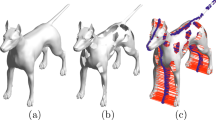Abstract
In this paper we discuss the implementation of methods to derive 3D Symmetry Sets, given a parameterized shape, as well as an unorganized point cloud. It presents a geometric method to derive the Symmetry Set, that is an extension of the one given in [6]. Although the mathematics is a simple extension of the 2D case, the visualization, numerical computations and their stability are much more complicated. An example is given by means of an ellipsoid. In this example the Symmetry Set can be computed exactly and results can be compared to the ground truth.
This work is part of the DSSCV project supported by the IST Programme of the European Union (IST-2001-35443). WWW home page: http://www.itu.dk/Internet/sw1953.asp
Preview
Unable to display preview. Download preview PDF.
Similar content being viewed by others
References
Bruce, J.W., Giblin, P.J., Gibson, C.: Symmetry sets. Proceedings of the Royal Society of Edinburgh 101(A), 163–186 (1985)
Giblin, P.J., Kimia, B.B.: Transitions of the 3D medial axis under a one-parameter family of deformations. In: Heyden, A., Sparr, G., Nielsen, M., Johansen, P. (eds.) ECCV 2002. LNCS, vol. 2351, pp. 718–734. Springer, Heidelberg (2002)
Giblin, P.J., Kimia, B.B.: A formal classification of the 3D medial axis points and their local geometry. IEEE Transactions on Pattern Analysis and Machine Intelligence 26(2), 238–251 (2004)
Hisada, M., Belyaev, A.G., Kunii, T.L.: Towards a singularity-based shape language: ridges, ravines, and skeletons for polygonal surfaces. Soft Computing 7(1), 45–52 (2002)
Koenderink, J.J.: Solid Shape. MIT Press, Cambridge (1990)
Kuijper, A., Olsen, O.F., Giblin, P.J., Bille, P., Nielsen, M.: From a 2D shape to a string structure using the symmetry set. In: Pajdla, T., Matas, J(G.) (eds.) ECCV 2004. LNCS, vol. 3022, pp. 313–325. Springer, Heidelberg (2004)
Leymarie, F.: 3D Shape Representation via Shock Flows. PhD thesis, Division of Enginering. Brown University, Providence, RI, 02912 (2003)
Leymarie, F., Kimia, B.B.: The shock scaffold for representing 3D shapes. In: Arcelli, C., Cordella, L.P., Sanniti di Baja, G. (eds.) IWVF 2001. LNCS, vol. 2059, pp. 216–228. Springer, Heidelberg (2001)
Leymarie, F., Kimia, B.B.: Computation of the shock scaffold for unorganized point clouds in 3D. In: Proceedings IEEE Computer Society Conference on Computer Vision and Pattern Recognition (CVPR 2003), vol. 1, pp. 821–827 (2003)
Porteous, I.: Geometric Differentiation - for the intelligence of curves and surfaces, p. 301. Cambridge University Press, Cambridge (1994)
Author information
Authors and Affiliations
Editor information
Editors and Affiliations
Rights and permissions
Copyright information
© 2005 Springer-Verlag Berlin Heidelberg
About this paper
Cite this paper
Kuijper, A., Olsen, O.F. (2005). Computing 3D Symmetry Sets; A Case Study. In: Fogh Olsen, O., Florack, L., Kuijper, A. (eds) Deep Structure, Singularities, and Computer Vision. DSSCV 2005. Lecture Notes in Computer Science, vol 3753. Springer, Berlin, Heidelberg. https://doi.org/10.1007/11577812_17
Download citation
DOI: https://doi.org/10.1007/11577812_17
Publisher Name: Springer, Berlin, Heidelberg
Print ISBN: 978-3-540-29836-6
Online ISBN: 978-3-540-32097-5
eBook Packages: Computer ScienceComputer Science (R0)




